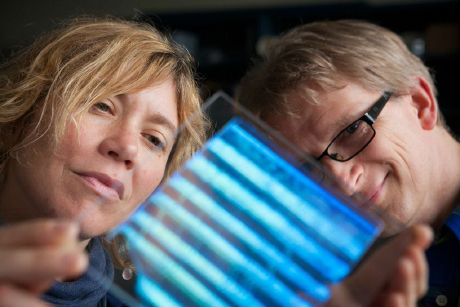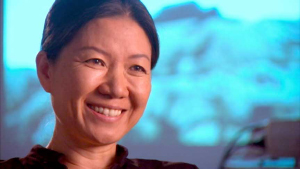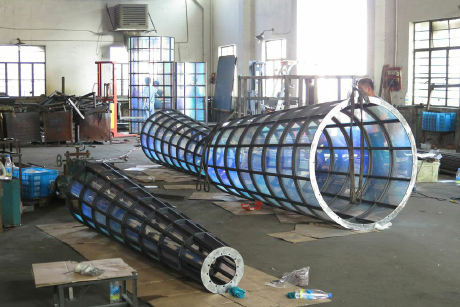Art and nanotech converge in campus biennial
By Daniel Aloi

For her newest work, Korean artist Kimsooja wanted to explore a “shape and perspective that reveals the invisible as visible, physical as immaterial, and vice versa.”
As artist-in-residence for the Cornell Council for the Arts’ (CCA) 2014 Biennial, she has realized that objective with “A Needle Woman: Galaxy was a Memory, Earth is a Souvenir,” to be installed on the Arts Quad next week. It will be one of several installations on campus for the semesterlong biennial, “Intimate Cosmologies: The Aesthetics of Scale in an Age of Nanotechnology,” beginning Sept. 18 with a talk by Kimsooja.
The biennial theme intends to “show how artists address realms of human experience that lie beyond our immediate sensory perception,” CCA Director Stephanie Owens said. “Working with scientists and researchers makes it possible to produce art at the edges between disciplines … generating lots of productivity and new thought.”

Kimsooja’s 46-foot-tall structure features an iridescent polymer film developed at Cornell, reflecting light with structural colors similar to those in a butterfly’s wings. Creating it involved some diligent problem-solving by materials scientists in the lab of Uli Wiesner, the Spencer T. Olin Professor of Engineering.
Owens first connected artists, musicians and scientists on campus in a series of lunchtime discussions two years ago. Wiesner said “I thought, this is what I really wanted to have in a university, a place of knowledge – [where] you can do stuff that goes beyond borders.”
Last November, Wiesner met with Owens and Kimsooja. “My group brought a glass vial that had a block of polymer dissolved in a solvent. It had iridescent colors, like an opal,” he said. “When you turned it, it was dynamic; the solution would flow around, and the colors changed. And Kimsooja loved it and said, ‘This is what I want on my structure.’”
The group, including chemistry Ph.D. student Ferdinand Kohle and postdoctoral researcher Hiroaki Sai, worked out how to create a polymer producing the desired optical effect and how to adhere it to Plexiglas panels on Kimsooja’s structure. Architecture students assisted with materials and fabrication.


The biennial, Sept. 15-Dec. 21, is a deep survey of artistic and scientific exploration, framing changes in 21st-century culture, art practice and nanoscale technology through collaborative research-based projects by faculty and students and guest artists Rafael Lazano-Hemmer, Paul Thomas and Kevin Raxworthy, and the Particle Group artist collective.
Cornell faculty members Beth Milles, performing and media arts; Jenny Sabin, architecture; and Juan Hinestroza and Ruya Ozer, fiber science, with So Yeon-Yoon, design and environmental analysis, have all developed biennial projects on the nano theme with students.
“I really love how world-class science has been incorporated in world-class art,” Hinestroza said of the Kimsooja-Wiesner project. “The fundamental science behind the coatings developed by the Wiesner group, the chemistry developed by Hiro, as well as the methods pioneered to coat the films with such nanoscale precision by Ferdinand, are indeed revolutionary – and the use of these materials to assemble a large structure like Kimsooja’s needle is simply breathtaking.”
Architecture student Joseph Kennedy ’15 and Caio Barboza and Sunny Xu, both B.Arch. ’13, created “Paperthin,” an interactive installation in the Physical Sciences Building based on the textured landscape of a sheet of paper at nanoscale. Physics researcher Robert Hovden, Ph.D. ’14, created “When Art Exceeds Perception,” a series of imperceptible nano-scale engravings of famous works of art.
As part of the biennial, the CCA brought artists Joe Davis, Nathaniel Stern, Stephanie Rothenberg and Berndnaut Smilde to speak on campus last spring. Owens taught a related course, Micro Materialities/Macro Forms: Artistic Practice and the Culture of Nanoscience, in fall 2013.
“Artists that engage research as part of their process,” Owens said, “can find partnership and shared vision with like-minded pioneers in [other] disciplines … and in doing so, catalyze aspects of their work that can take on new and unexpected directions.”
Biennial events
The Cornell Council for the Arts’ (CCA) 2014 Biennial, “Intimate Cosmologies,” features several events, installations and exhibitions by faculty, students and visiting artists:
- “Needle Woman” by Kimsooja, Sept. 19-Dec. 22 on the Arts Quad. The structure can be entered by viewers one at a time by appointment; e-mail cca@cornell.edu.
- “The Dimensions of a Needle,” Kimsooja artist talk, Sept. 18, 5:30 p.m. in Milstein Auditorium.
- Biennial Symposium, Sept. 19, with keynote speaker Paul Thomas, “Needle Women” project collaborators, panel discussions, 10 a.m., Milstein Auditorium.
- Biennial Reception, Sept. 19, 5-7 p.m. on the Arts Quad.
- A Sept. 20 workshop, “Creating an Art/Science Cloud Curriculum,” led by CCA Director Stephanie Owens and Australian artist and educator Paul Thomas, will lay the groundwork to establish a curriculum and other considerations for meaningful student engagement in an integrated study of studio art and research-based science.
- “Nanowhere,” Sept. 18-Oct. 3 in Martha Van Rensselaer Hall Gallery, a project by Cornell researchers Juan Hinestroza, Ruya Ozer and So-Yeon Yoon, with wearable sensors that detect methane and poisonous gases in a sealed gas chamber, and 3-D visual art.
- “Paperthin,” Sept. 15-Dec. 10 in the Physical Sciences Building Atrium, renders the textures of a sheet of paper at the nano scale as a 3-D landscape at regular scale, created by Joseph Kennedy, B.Arch. ’15, and Caio Barboza and Sonny Xu, both B.Arch. ’13.
- “ColorFolds: eSkin + Kirigami,” by Sabin Design Lab, directed by architecture professor Jenny Sabin, opens Sept. 19 on the third floor of East Sibley Hall. The interactive prototype of adaptive, foldable architecture features structural color change of a façade material, with nano- and micro-scale features and effects inspired by human cells plated on geometrically defined substrates.
- “Nanoessence,” by Paul Thomas and Kevin Raxworthy, Sept. 22-Oct. 10 in John Hartell Gallery, Sibley Hall. The installation compares atomic structures and vibrations between living and dead skin cells when touched by the Atomic Force Microscope (AFM) cantilever.
- “Illuminated Nanoscripts, Nanopoems and Nanogarage(s),” by Particle Group, Sept. 22-Nov. 15 on the Johnson Museum façade and in the Human Ecology Building’s Jill Stuart Gallery.
- “The Charles Babbage Memorial Nano Leaflets” by Rafael Lozano-Hemmer, Oct. 1-Dec. 22 in Sibley Dome, includes millions of microscopic leaflets made of pure 24K elemental gold, nano-etched with text by 19th-century polymath Charles Babbage, who invented the first mechanical computer.
Additional events and exhibitions will be announced.
Media Contact
Get Cornell news delivered right to your inbox.
Subscribe